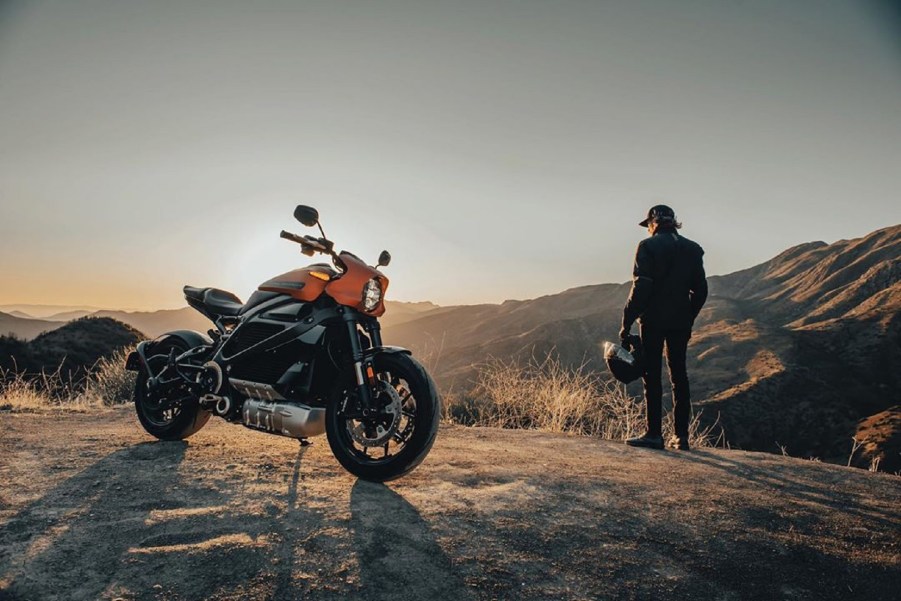
Harley-Davidson’s LiveWire Should’ve Learned From Zero Motorcycles
Despite taking off from the line quickly, Harley-Davidson’s electric LiveWire hasn’t really taken off in terms of sales figures. And the American motorcycle company’s future as a whole doesn’t look terribly bright. Which is a shame for electric motorcycle fans, because the LiveWire itself is a well-made bike. But in making it, Harley should’ve taken a page from Zero Motorcycles’ book.
Harley-Davidson’s vs. Zero Motorcycles’ electric bikes
The issues that the Harley-Davidson LiveWire faces boil down to what separates it and Zero Motorcycles’ lineup. Namely, that Zero Motorcycles has an entire electric lineup.
True, the LiveWire beats out even Zero’s range-topping SR/F in many ways, Cycle World reports. It’s more efficient, accelerates faster, and simply feels more premium. However, it also starts at $29,799—but isn’t compatible with Level 2 chargers. And if you want a cheaper electric Harley-Davidson, there isn’t one available.
On the other hand, Zero’s cheapest bike, the FX dual-sport, starts at $8995. While there are some cheaper excellent used cars, that’s still significantly more affordable. And Zero Motorcycles has other models that slot between the FX and SR/F. But the LiveWire’s starting price is only part of the problem.

To paraphrase Roadshow, the Harley-Davidson LiveWire is another premium bike at a premium price. It’s a halo product, meant to elevate the status of other motorcycles in the showroom. But Harley already sells other bikes that are even more expensive than the LiveWire.
And a halo product only works if there’s an angel underneath. Harley was planning on releasing other electric products, Outside reports, including e-bikes. But so far, there’s only the LiveWire.

With Zero, on the other hand, the SR/F serves as a good halo bike because there are cheaper options available. You can get spend more to get more performance but still, stay within Zero’s lineup.
But the halo product vs. lineup differences, and indeed, the pricing differences, go even further.
The LiveWire hasn’t led to much growth
Compared to Harley-Davidson, Zero Motorcycles is significantly smaller in terms of sales. According to MotorCycles Data, the California-based company only sold about 3000 bikes worldwide in 2019. In contrast, according to Statista, Harley’s US sales, though down, were just under 126,000.

However, while Harley sells more bikes, Zero sells more technology. For example, Zero Motorcycles helped Curtiss transition from internal-combustion to all-electric. It’s also collaborated with Ural to produce an electric prototype.
In addition, not only have Zero’s bikes gotten more range, they’ve actually gotten cheaper. Today, the Zero S costs $10,995 and has a claimed 89-mile city range. But when it debuted in 2009, it cost the equivalent of $11,900 and maxed out at 60 miles, Motorcyclist reports.

True, the LiveWire is a significantly newer product. And it’s not like there aren’t other expensive electric motorcycles, like the Tarform Luna. But that’s coming from a company that’s just starting up. Also, in terms of new technology, the Luna is arguably more forward-thinking than the LiveWire. Plus, Energica’s Eva EsseEsse9+ out-performs Harley-Davidson’s electric bike in range and horsepower, but costs about $8000 less.
In March 2018, Harley-Davidson announced it was investing in electric motorcycle company Alta Motors. This was just after the first LiveWire prototypes were shown off, RideApart reports. And yet, 6 months later, the partnership was dissolved, and Alta went bankrupt. Seemingly nothing has come out of it.
Plus, Harley’s brand image still hasn’t changed. According to Reuters, the LiveWire is targeted at customers “with incomes above $100,000 per year.” And most orders came from “existing and old riders.” Those orders, meanwhile, are estimated to be between 400-1600. In other words, less than Zero’s total 2019 sales.
Harley-Davidson’s potential next steps
Ultimately, the Harley-Davidson LiveWire shows that the company could build an electric Harley. But Zero Motorcycles is about building up the presence of electric motorcycles, period. So, what does this mean for Harley?
For the moment, the company appears to be focusing on its premium image by artificially cutting production, The Drive reports. But if it’s doing that, I’d argue the LiveWire simply doesn’t make sense. It doesn’t sound like a traditional Harley-Davidson, nor look quite like one. If Harley’s sticking to its leather-bound ‘bad boy’ image, the LiveWire will likely go the way of the V-Rod anyway.
However, if Harley truly does want to change, then it needs to commit itself further. Tesla’s already demonstrated that making a cheaper EV doesn’t ruin a luxury or premium image. Collaborate with other motorcycle makers, especially ones involved in electric bikes. Indian’s owner, Polaris, owns the electric bike company Brammo, after all. And if GM can work with Ford, Harley-Davidson can work with Indian. Or maybe, Zero Motorcycles can show Harley a thing or two.
Follow more updates from MotorBiscuit on our Facebook page.


